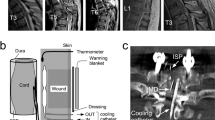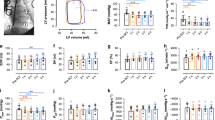Abstract
Gastric ulcers are an important cause of morbidity and mortality in the critically ill, especially those with CNS injury. We used cervical spinal cord transection (CCT) in the rat to model these ulcers and examined the effect of core body temperature and vascular volume on gastric ulcerogenesis. Hypothermia significantly increased ulcerogenesis compared to euthermia, while maintained euthermia produced ulcer indices not different from sham surgery. Hypovolemia (10% blood volume withdrawal) significantly increased ulcerogenesis compared to hypervolemia (10% of blood volume crystalloid infusion) or sham surgery. These results support crystalloid infusion and maintenance of core body temperature in the clinical setting.
Similar content being viewed by others
References
Cheung LY: Treatment of established stress-ulcer disease. World J Surg 5:235–240, 1981
Yang YX, Lewis JD: Prevention and treatment of stress ulcers in critically ill patients. Semin Gastrointest Dis 14:11–19, 2003
Spirt MJ: Stress–related mucosal disease: Risk factors and prophylactic therapy. Clin Therapeut 26:197–213, 2004
Haglund U: Stress ulcers. Scand J Gastroenterol Suppl 175:27–33, 1990
Marrone GC, Silen W: Pathogenesis, diagnosis and treatment of acute gastric mucosal lesions. Clin Gastroenterol 13:635–650, 1984
Lucas CE, Sugawa C, Riddle J, Rector F, Rosenberg B, Walt AJ: Natural history and surgical dilemma of “stress” gastric bleeding. Arch Surg 102:226–273, 1971
Hastings PR, Skillman JJ, Bushnell LS, Silen W: Antacid titration in the prevention of acute gastrointestinal bleeding. Controlled, randomized trial in 100 critically ill patients. N Engl J Med 298:1041–1045, 1978
Zinner MJ, Zuidema GD, Smith PL, Mignosa M: The prevention of upper gastrointestinal tract bleeding in patients in an intensive care unit. Surg Gynecol Obstet 153:214–220, 1981
Faist E, Baue AE, Dittmer H, Heberer G: Multiple organ failure in polytrauma patients. J Trauma 23:775–787, 1983
Glavin GB, Murison R, Overmier JB, Pare WP, Bakke HK, Henke PG, Hernandez DE: The neurobiology of stress ulcers. Brain Res Rev 16:301–343, 1991
Selye H: Syndrome produced by diverse nocuous agents. Nature 138:32, 1936
Selye H: Studies on adaptation. Endocrinology 21:169–188, 1937
Frank JD: Production of the alarm reaction in young rats by transection of the spinal cord. Endocrinology 27:447–451, 1940
Ader R: Gastric erosions in the rat: effects of immobilization at different points in the activity cycle. Science 145:406–407, 1964
Brown SD, Finger FW: Circadian variation of ulcer-susceptibility in the rat. In Chronobiology. Proceedings of the Symposium of the International Society for Chronobiology, Little Rock, AK, 1971. LE Scheving, F Halberg, JE Pauly (eds). Tokyo, Igaku Shoin, 1974, pp 316–319
Olson CE, Soll AH, Guth PH: Circadian variation of susceptibility to gastric mucosal injury by acidified aspirin or absolute ethanol in the rat. Gastroenterology 91:1192–1197, 1986
Szabo S, Pfeiffer D, Oishi T: The chronopharmacology of drug-induced gastric and duodenal ulcers. Annu Rev Chronopharmacol 3:383–384, 1986
MacLellan DG, Shulkes A, Hardy KJ: Profile of gastric stress ulceration following acute cervical cord injury: an animal model. Aust NZ J Surg 56:499–504, 1986
MacLellan DG, Shulkes A, Yao CZ, Hardy KJ, Thompson JC: Role of vagal hyperactivity in gastric stress ulceration after acute injury to the cervical cord. Surg Gynecol Obstet 166:441–446, 1988
Waldrop RD, Rubin NH, MacLellan DG, Rayford PL, Thompson JC: Daily variations in the formation of gastric ulcers caused by cervical cord transection in the rat. Gastroenterology 94:1080–1082, 1988
Atkinson PP, Atkinson JL: Spinal shock. Mayo Clin Proc 71:384–389, 1996
Fehlings MG, Louw D: Initial stabilization and medical management of acute spinal cord injury. Am Fam Physician 54:155–162, 1996
Waldrop RD, Strain GM: Autonomic regulation of gastric ulcerogenesis after cervical cord transection in the rat. Acad Emerg Med 5:230–233, 1998
Sigman HH, Gillich A: Role of hypothermia in the production of gastric ulcers in a rat spinal cord transection model. Dig Dis Sci 26:60–64, 1981
Sato N, Kawano S, Kamada T, Takeda M: Hemodynamics of the gastric mucosa and gastric ulceration in rats and in patients with gastric ulcer. Dig Dis Sci 31 (Feb Suppl):35S–41S, 1986
Filaretova L, Maltcev N, Bogdanov A, Levkovich Y: Role of gastric microcirculation in the gastroprotection by glucocorticoids released during water-restraint stress in rats. Chin J Physiol 42:145–152, 1999
Murakami M, Lam SK, Inada M, Miyake T: Pathophysiology and pathogenesis of acute gastric mucosal lesions after hypothermic restraint stress in rats. Gastroenterology 88:660–665, 1985
Koo MW, Cho CH, Ogle CW: Role of gastric glandular mucosal energy metabolism in cold-restraint gastric lesion formation. Arch Int Pharmacodyn Ther 326:84–94, 1993
Weiner H: Use of animal models in peptic ulcer disease. Psychosom Med 58:524–545, 1996
Yang H, Wu SV, Ishikawa T, Tache Y: Cold exposure elevates thyrotropin-releasing hormone gene expression in medullary raphe nuclei: relationship with vagally mediated gastric erosions. Neuroscience 61:655–663, 1994
Hovendal CP, Bech K, Gottrup F, Andersen D: Adrenergic influence on gastric mucosal blood flow in gastric fistula dogs. Scand J Gastroenterol Suppl. 89:41–44, 1984
Buchel L, Gallaire D: Ulcéres de contrainte chez le rat. I. Influence, sur la fréquence des ulceres, du jeûne, et de la température de l'environment associés á des immobilisations de durées variables [Restraint ulcers in rats. I. Influence, on the frequency of ulcers, of fasting and environmental temperature associated with immobilization of variable duration]. Arch Sci Physiol (Paris) 21:527–536, 1967
Witty RT, Long JF: Effect of ambient temperature on gastric secretion and food intake in the rat. Am J Physiol 219:1359–1362, 1970
Martin MS, Martin E, Lambert R: The effect of ambient temperature on restraint ulcer in the rat. Digestion 3:331–337, 1970
Arai I, Muramatsu M, Aihara H: Body temperature dependency of gastric regional flow, acid secretion and ulcer formation in restraint and water-immersion stressed rats. Jap J Pharmacol 40:501–504, 1986
Boyd EJS, Wormsley KG: Etiology and pathogenesis of peptic ulcer. In Bockus Gastroenterology, 4th ed. JE Berk, WS Haubrich, MH Kalser, JLA Roth, F Schaffner (eds). Philadelphia, Saunders, 1985, pp 1013–1059
Sorbye H, Svanes K: The role of blood flow in gastric mucosal defense, damage and healing. Dig Dis 12:303–317, 1994
Hayase M, Takeuchi K: Gastric acid secretion and lesion formation in rats under water–immersion stress. Dig Dis Sci 31:166–171, 1986
Niida H, Takeuchi K, Okabe S: Role of thyrotropin–releasing hormone in acid secretory response induced by lowering of body temperature in the rat. Eur J Pharmacol 198:137–142, 1991
Murison R, Overmier JB: Some psychosomatic causal factors of restraint–in–water stress ulcers. Physiol Behav 53:577–581, 1993
Carmine AA, Brogden RN: Pirenzepine. A review of its pharmacodynamic and pharmacokinetic properties and therapeutic efficacy in peptic ulcer disease and other allied diseases. Drugs 30:85–126, 1985
Author information
Authors and Affiliations
Corresponding author
Additional information
This work was supported by funds from the Southern Medical Association.
Rights and permissions
About this article
Cite this article
Strain, G.M., Waldrop, R.D. Temperature and Vascular Volume Effects on Gastric Ulcerogenesis After Cord Transection. Dig Dis Sci 50, 2037–2042 (2005). https://doi.org/10.1007/s10620-005-3004-z
Received:
Accepted:
Issue Date:
DOI: https://doi.org/10.1007/s10620-005-3004-z




